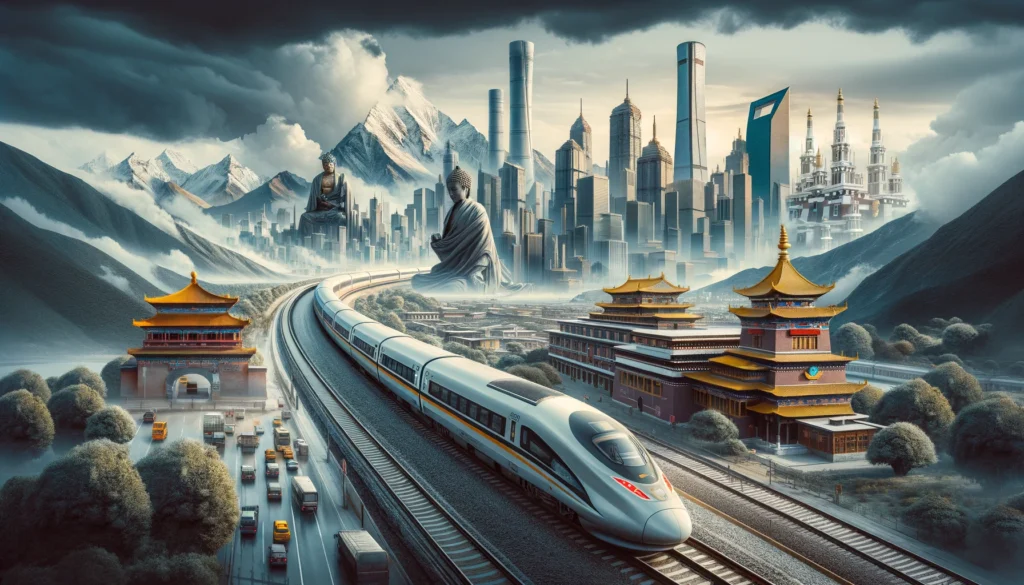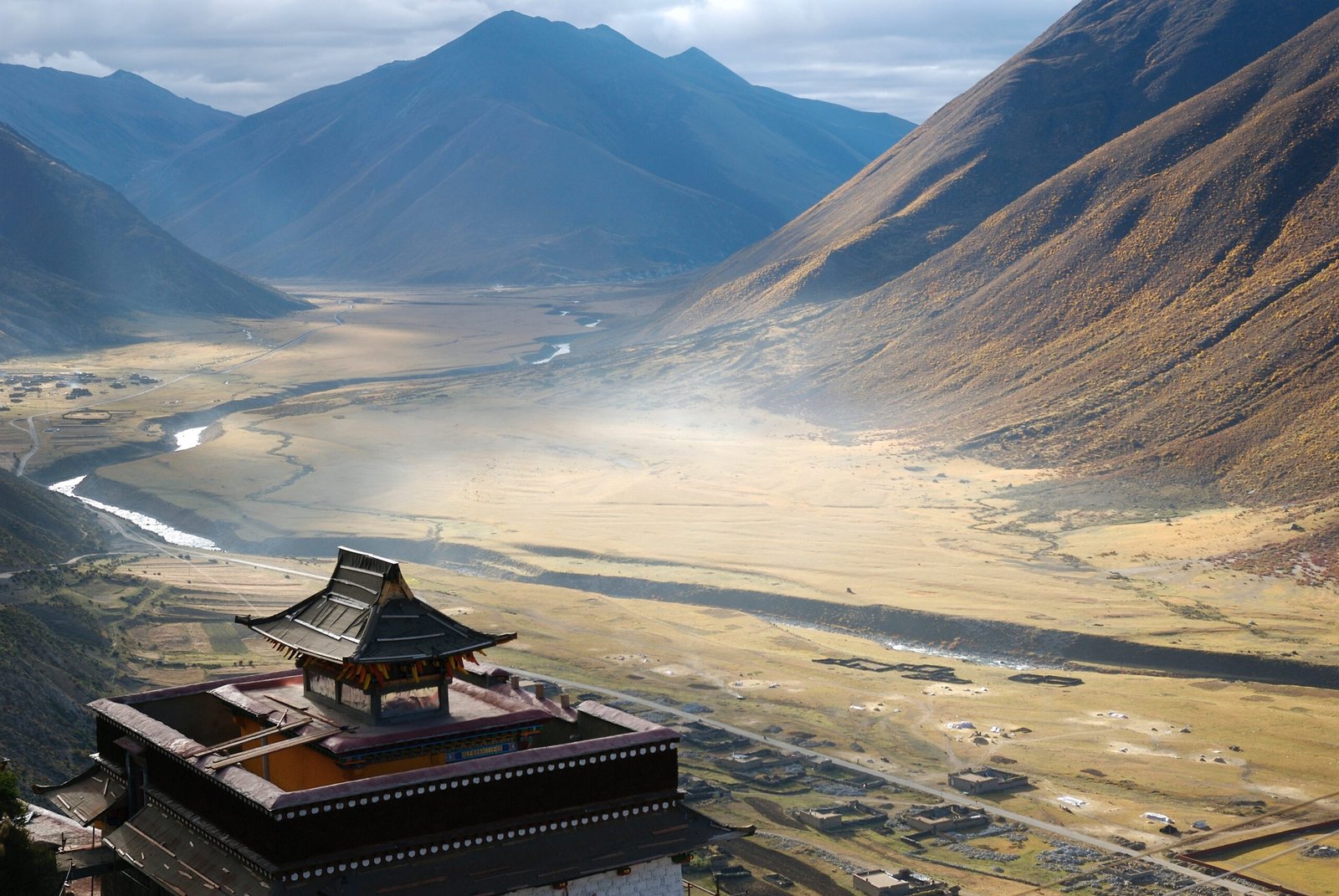Introduction to the Beijing-Lhasa Adventure
Travelling from Beijing to Lhasa offers a unique opportunity to explore the diverse landscapes of China. There are primarily two routes to embark on this journey, each presenting its own set of experiences and scenic beauty.
The Direct Beijing-Lhasa Express (Route 1)
The Z21 train, commonly known as the “Beijing-Lhasa Express,” provides a direct and efficient journey from Beijing to Lhasa. After departing from Beijing, the train traverses westward, crossing the loess-covered Yellow Plateau, marked by its striking blue lines on maps. Key stops along this route include Taiyuan, Zhongwei, and Lanzhou, before ascending onto the Tibetan Plateau. This route is the quickest way to Lhasa, with no need for transfers, making it ideal for those with limited time.
Key Highlights:
- Scenic Views of the Yellow Plateau: Witness the unique landscapes of this region.
- Efficient Travel: Direct route with minimal stops.

The Scenic Detour via Zhengzhou (Route 2)
For travellers with more time, the second route offers a more scenic experience. Starting from Beijing, the journey follows the Beijing-Guangzhou line to Zhengzhou. From there, it heads west, ascending the Yellow River in reverse, passing through historic cities such as Luoyang, Xi’an, and Tianshui before reaching Lanzhou. The final leg of the journey merges with the Qinghai-Tibet railway, leading to Lhasa.
Cultural and Scenic Splendors:
- Historic Cities: Explore the rich history of Luoyang and Xi’an.
- Breathtaking Landscapes: Enjoy the picturesque views of the Qinling and Taihang Mountains.
- Cultural Corridor: Immerse yourself in China’s most vibrant cultural regions.
The North China Plain: A Starting Point
The journey begins on the North China Plain, the lowest step of China’s stair-like topography. This region, with an average elevation of 200 meters, is known for its flat and fertile land. It’s densely populated with numerous towns and cities. The most common crops here are wheat, corn, and rice.
Exploring the Heartland:
- Agricultural Richness: Witness the vast farmlands and traditional agriculture.
- Urban Landscapes: Experience the diverse urban settings along the route.
A Journey of Contrast and Discovery
Whether you choose the direct express or the scenic detour, travelling from Beijing to Lhasa by train offers an unparalleled experience of China’s geographical diversity and cultural richness. Each route presents its unique narrative, unfolding the beauty and complexity of the Chinese landscape.
A Grand Tour from Beijing to Lhasa: An Epic Train Journey Through China’s Heartland
Chapter One: The Majesty of Beijing – The Starting Point
Beijing: A Blend of Ancient Grandeur and Modern Vitality
Beijing, the capital of China, stands at the northern edge of the North China Plain. It is a city steeped in history, serving as the seat of six dynasties over three millennia – the Yan, Liao, Jin, Yuan, Ming, and Qing. This rich historical tapestry has endowed Beijing with a profound cultural heritage.
Since 1949, Beijing has evolved rapidly as the political, economic, and cultural centre of modern China, transforming into one of the world’s most renowned metropolises. The city’s skyline, a mix of ancient architecture and modern skyscrapers, tells a story of a civilization that has endured and flourished through the ages.
Historical and Cultural Landmarks
The Forbidden City
The Forbidden City, also known as the Imperial Palace, is a monumental testament to China’s Ming and Qing dynasties. Built-in 1406, it is the world’s largest and best-preserved wooden palace complex. Since 1925, it has housed the Palace Museum, showcasing a vast collection of imperial artefacts.
The Temple of Heaven
This imperial complex, used for ceremonies dedicated to the heavens, is an architectural marvel of the Ming and Qing dynasties. The Echo Wall, surrounding the Imperial Vault of Heaven, is a unique acoustic wonder.
The Summer Palace
The largest royal park in China, it comprises Wanshou Hill and Kunming Lake. Its Long Corridor, adorned with thousands of exquisite paintings, stands as a testament to the grandeur of imperial China.
The Great Wall at Badaling
Badaling is the most famous section of the Great Wall of China, known for its strategic importance and stunning views. It’s a symbol of China’s historical resilience and a must-visit site for global dignitaries.
Traditional Beijing: Hutongs and Courtyards
The city’s ancient alleyways and traditional courtyard houses offer a glimpse into the authentic lifestyle of old Beijing. Areas like the South Luogu Alley and Yandai Byway are particularly renowned for their well-preserved cultural ambience.
Museums Galore
With over 170 museums, Beijing is a treasure trove of history and culture. Highlights include the National Museum of China, the largest museum of Chinese history; the China Aviation Museum, showcasing a vast collection of aircraft; and the Military Museum of the Chinese People’s Revolution, offering insights into China’s military history.
Modern Architectural Marvels
Beijing’s contemporary architecture, like the Bird’s Nest, Water Cube, and the CCTV Headquarters, reflects the city’s modernization and global stature.
Chapter Two: The Loess Plateau – A Journey Through Time
The Loess Plateau: A Unique Landscape
The Loess Plateau, characterized by its yellow earth and unique topography, offers a stark contrast to the urban sprawl of Beijing. Traditional cave dwellings and terraced fields dot this region, providing a window into a rural lifestyle that has endured for centuries.
Key Stops in the Loess Plateau
Xi’an: The Terracotta Warriors and Ancient Capital
Xi’an, the capital of Shaanxi Province, is home to the famous Terracotta Army of Emperor Qin Shi Huang. This ancient city, once the eastern terminus of the Silk Road, boasts a rich history as a former imperial capital.
Tianshui: The Majiayao Culture and Grottoes
Tianshui, with its ancient grottoes and archaeological sites, offers a glimpse into the prehistoric Majiayao culture, known for its colorful pottery.
Lanzhou: The Yellow River and Gansu’s Capital
Lanzhou, the capital of Gansu Province, straddles the Yellow River. The city is a blend of cultural influences, reflected in its cuisine, architecture, and museums.
Chapter Three: The Tibetan Plateau – The Roof of the World
The Tibetan Plateau: A Land of Spiritual and Natural Beauty
Entering the Tibetan Plateau, the landscape transforms dramatically. Vast, sky-touching mountains, deep valleys, and crystal-clear lakes define this region, known as the “Roof of the World.”
Lhasa: The Heart of Tibetan Buddhism
Lhasa, the capital of Tibet, is a city of profound religious significance. Sites like the Potala Palace and Jokhang Temple are not just architectural marvels but also central to Tibetan Buddhism.
Natural Wonders: Lakes and Mountains
The Tibetan Plateau is dotted with sacred lakes like Namtso and Yamdrok, offering serene beauty and spiritual significance.
Cultural Insights: Monasteries and Festivals
Tibet’s rich culture is best experienced through its vibrant festivals and monastic traditions. Visiting monasteries like Sera and Drepung provides deep insights into the spiritual life of the Tibetan people.
Conclusion: A Journey of Diversity and Discovery
This journey from Beijing to Lhasa is more than a train ride; it’s a voyage through China’s heart and soul. From the bustling streets of Beijing to the tranquil heights of the Tibetan Plateau, each stop offers a unique blend of history, culture, and natural beauty. This journey is not just about the destinations but the myriad experiences and stories that weave the rich tapestry of China’s diverse landscape.


